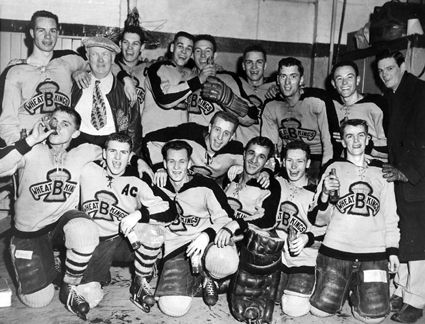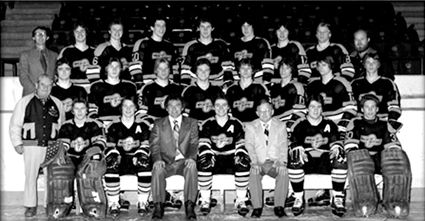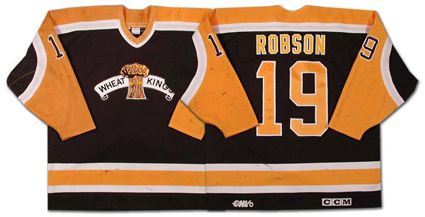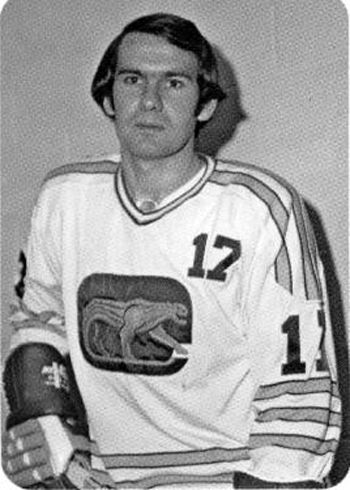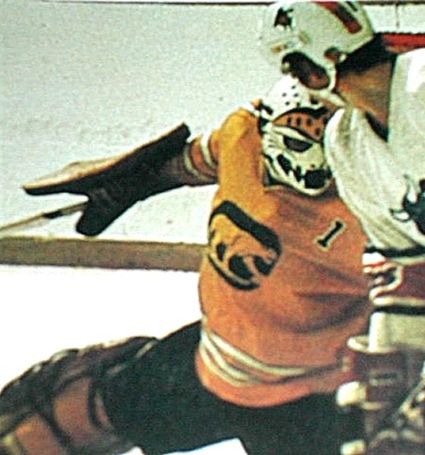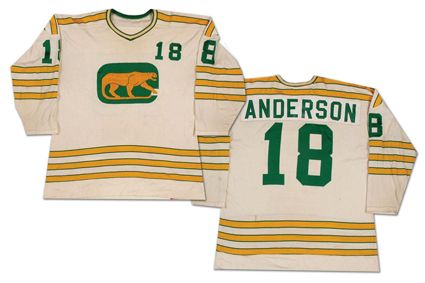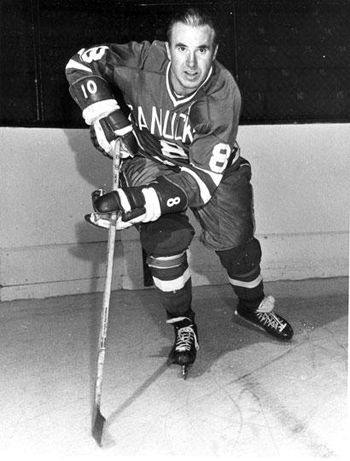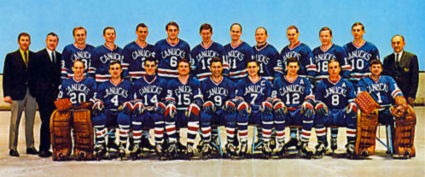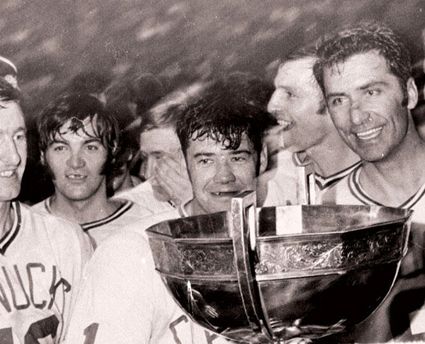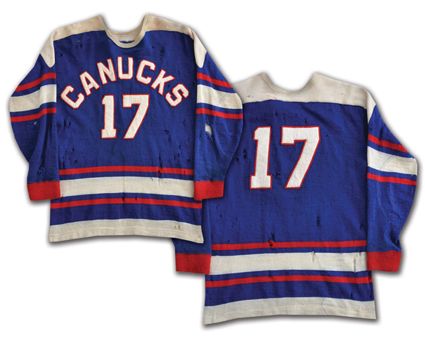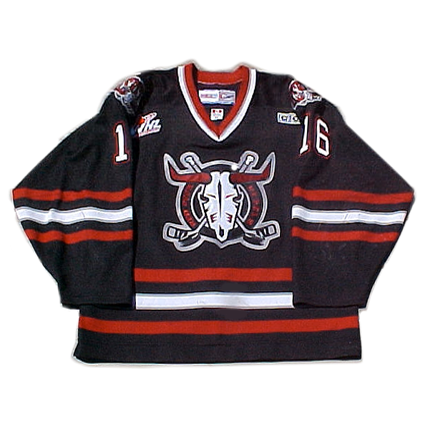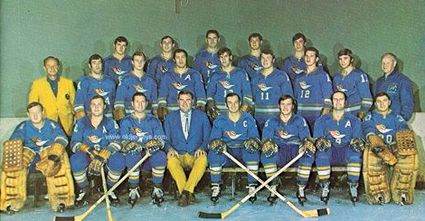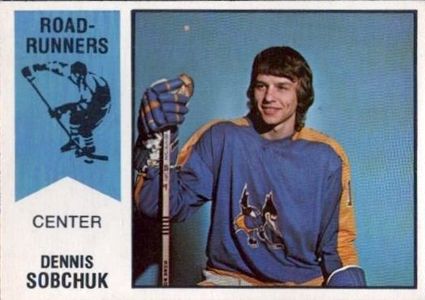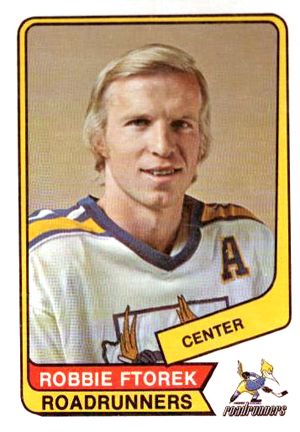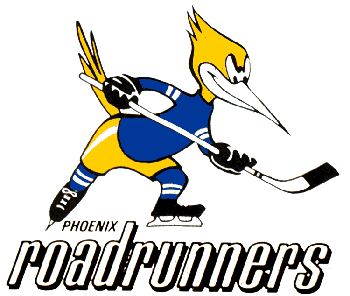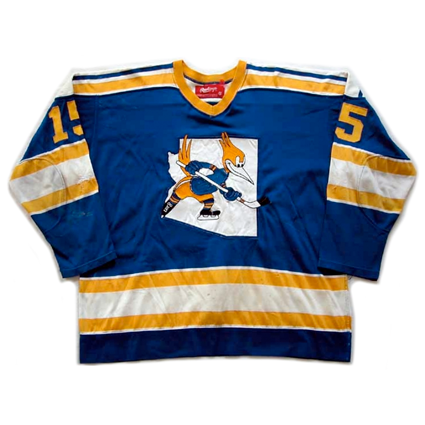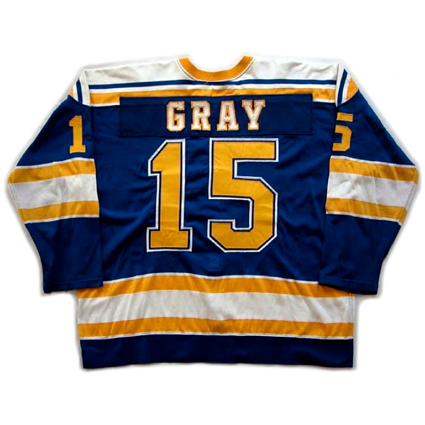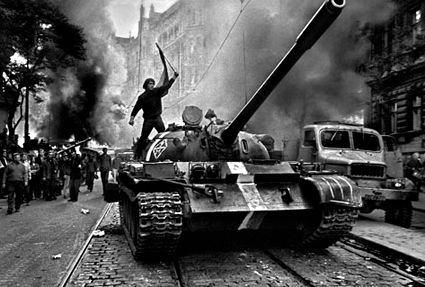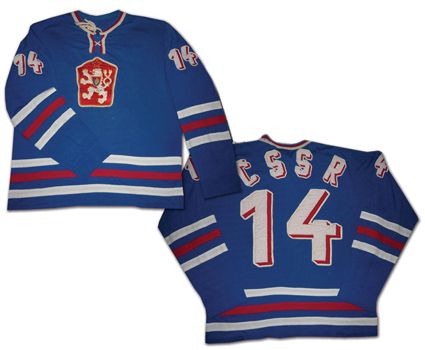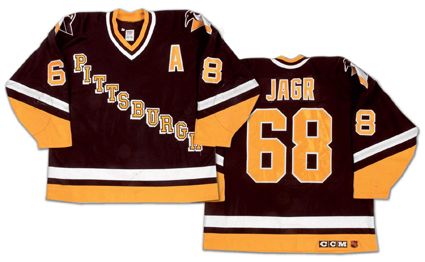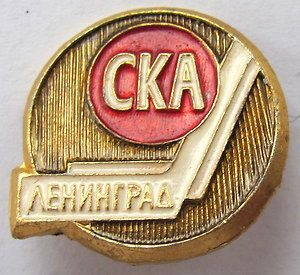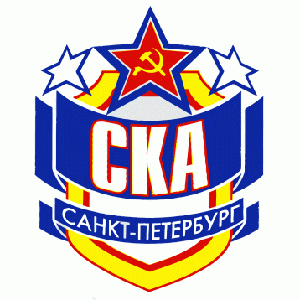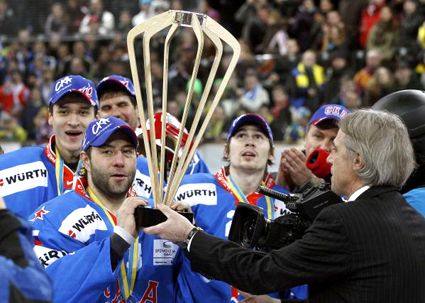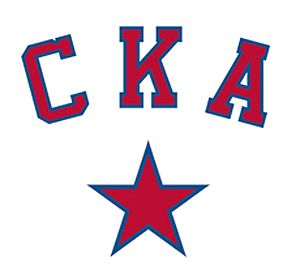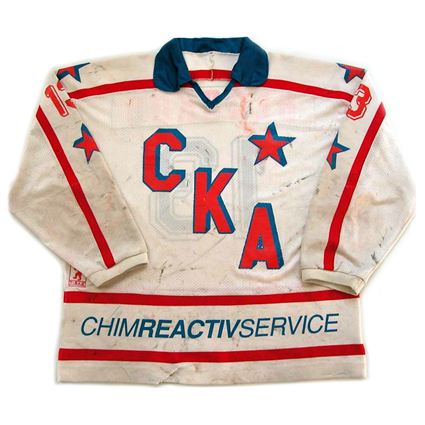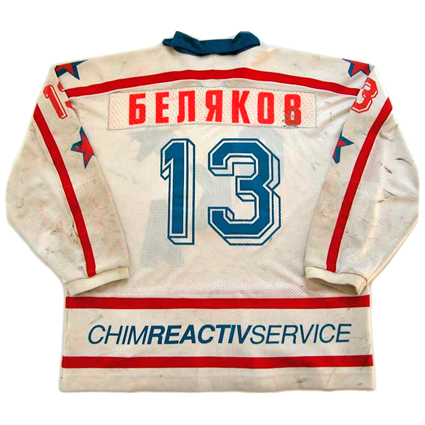Saturday, July 19, 2014
1997-98 Brandon Wheat Kings Ryan Robson Jersey
July by the Numbers returns to Canada for jersey #19.
Founded in 1936 as a member of the Manitoba Junior Hockey League, the Brandon Wheat Kings competed in the MJHL for two seasons prior to changing their name to the Brandon Elks for two seasons, which included winning the MJHL championship and the Turnbull Cup in 1938-39.
Following a five year hiatus for World War II, the club returned to the ice for the 1945-46 season as well as returning to the name Wheat Kings to reflect the agricultural nature of their surrounding community in western Manitoba. The club quickly found their stride, winning championships in 1947, 1949 and 1950. They also went on to capture the 1949 Abbott Cup as champions of all of western Canada after defeating the Calgary Buffaloes.
After competing for four more seasons through 1953-54, the club once again went dormant for four seasons from 1954-55 to 1957-58.
The 1953-54 Brandon Wheat Kings
Similar to their previous break during World War II, the Wheat Kings returned with a vengeance. After a third place finish in 1958-59, Brandon reeled off five consecutive first place finishes and converted that dominance into four league playoff victories in five tires, winning titles in 1960, 1962, 1963 and 1964, after a regular season record of 27-1-2! During their five year period of MJHL dominance, the Wheat Kings posted a combined record of 132-34-7.
After three more seasons in the MJHL, the Wheat Kings joined the Western Hockey League for the 1967-68 season where they found life a lot harder going, as it was not until ten seasons for them to achieve a first place regular season finish, all without any playoff success.
The 1976-77 club was led by the trio of Bill Derlago (a WHL record 96 goals and 178 points), Ray Allison (137 points) and Brian Propp (135 points) who took the top three places in the WHL scoring race. They repeated their first place finish in 1977-78 with Propp taking the scoring title with 182 points, but it all really came together in 1978-79 when the Wheat Kings set not only a WHL record, but a Canadian Hockey League (encompassing both the Ontario Hockey League and Quebec Major Junior Hockey League as well) with a stellar 58-5-9 record for 125 points. Propp set the all-time franchise record, as well as setting a new WHL single season scoring record, with 194 points to take his second straight scoring title, 39 points clear of second place teammates Allison (153 points) and Laurie Boschman (149 points).
The 1978-79 Brandon Wheat Kings
Brandon went on to capture the Ed Chynoweth Cup as WHL playoff champions, which earned them a place in the Memorial Cup. While the Wheat Kings finished first in the round robin portion, they lost in the final 2-1 in overtime.
The Wheat Kings fell into a down period with 13 seasons with only one finish above 5th and eight seasons out of the playoffs. The highlight of this era was the 1983-84 season when Ray Ferarro set a WHL record with 108 goals on his way to a league scoring title with 192 points. Cam Plante also set an all-time league record with 140 points for a defenseman that same season.
Beginning in 1992-93, the Wheat Kings rebounded with back-to-back second place finishes before a trio of first place finishes from 1995 to 1997 and another Memorial Cup appearance in 1995 and a playoff championship and subsequent Memorial Cup appearance in 1996.
Five seasons later they were back on top once again for three of the next four seasons (2002, 2003 and 2005), but playoff success eluded them each time. In 2004-05 a trio of Wheat Kings again led the WHL in scoring - Eric Fehr (111 points), Ryan Stone (99 points) and Tim Konsorada (87 points).
Since then the Wheat Kings have managed a pair of first place finishes in 2006-07 and 2009-10, a season during which they also hosted the Memorial Cup and were able to reach the final.
Other notable players for Brandon include Ron Hextall, Brian McCabe, Brad McCrimmon, Jeff Odgers, Chris Osgood, Wade Redden, Jordin Tootoo and Oleg Tverdovsky.
Today's featured jersey is a 1997-98 Brandon Wheat Kings Ryan Robson jersey. This jersey uses the template of the Philadelphia Flyers traditional jersey where the stripe down the arm wraps around the wrists, a look that was much more popular back in the 1980's when it was also used by the Los Angeles Kings.
Labels:
Brandon Wheat Kings
Friday, July 18, 2014
1972-73 Chicago Cougars Ron Anderson Jersey
July by the Numbers visits the Windy City for jersey #18.
One of the founding member clubs of the World Hockey Association, the Chicago Cougars had a tremendous challenge ahead of them as they took on the established Chicago Black Hawks of the NHL on their own turf.
Unlike other WHA clubs who took on NHL teams by playing as tenants in the NHL's home arenas, such as the New York Raiders and Toronto Toros, the Cougars made the ancient International Amphitheater, built in 1934, their "temporary" home, with the hopes of relocating to the Rosemont Horizon when it was completed.
The Cougars opening game was a memorable affair, as the club hosted former Black Hawks standout Bobby Hull and the Winnipeg Jets, who Chicago defeated by a score of 3-1. The remainder of the season proved to be tough going, as the club finished dead last in the WHA with a 26-50-2 record and just 54 points in the standings, 14 behind the Raiders. The team was led in scoring by Bob Sicinski with 88 points and Rosarie Paiement's team leading 33 goals.
Bob Sicinski
With changes obviously needed, veteran leadership was provided by long time Montreal Canadien Ralph Backstrom who was lured away from the Black Hawks along with Pat Stapleton. Backstrom led the Cougars offensively with 33 goals, 50 assists and 83 points and Paiement also reached 30 goals once again while Stapleton had 52 assists from the blueline to lead the team in that category.
The signing of Ralph Backstrom
While the club improved in the standings to 81 points, it was only good for fourth in the Eastern Division, one point ahead of the Quebec Nordiques for the final playoff spot. Once in the playoffs, the Cougars upset the top seeded and defending champions the New England Whalers in seven games, including the final game on the road in Boston.
In one of the typically odd stories surrounding the WHA, the Cougars were unable to play their second round home playoff games against the Toronto Toros in the International Amphitheater due to a traveling production of "Peter Pan" with former Olympic gymnast Cathy Rigby in the title role having been booked into the arena.
An unsuccessful attempt was made to move the games to Chicago Stadium, home of the Black Hawks and the team settled on the undignified solution of playing it's games at a suburban shopping center in Randhurst, where they was a public skating rink called the Randhurst Twin Ice Arena which could hold only 2000 spectators!
The Cougars managed survive this indignity to win two of their three games in Randhurst and play well enough on the road to force a Game 7, which they won on the road to make a surprising appearance in the Avco Cup Finals.
With the Peter Pan show having concluded, the team expected to return to their home rink for the finals, only to find out they arena staff had melted the ice surface and the pipes used to chill the ice were being dismantled for the offseason! Apparently the arena and it's staff were not fans of the team and hadn't been following the Cougars progress against the Toros...
Forced to return to Randhurst, they were swept by Gordie Howe and the Houston Aeros in four straight where the Aeros took the title in the tiny arena next to the shopping mall. The bad publicity from the arena situation caused a sportswriter to come up with one of the all-time classic quotes, "The Cougars were beaten by the greatest lightweight of them all - Peter Pan."
Rookie Gary MacGregor led the 1974-75 Cougars with 42 goals and 76 points, two ahead of Paiement's 74. Dave Dryden came over from the NHL to tend goal. Things were not going well at the box office though, and the team was facing a major financial crisis which threatened to put the team out of business during the 1974-75 season, but the team's three major players, Backstrom, Stapleton and Dryden, purchased the team to keep it going through the end of the season in which the Cougars dropped to 12th place overall out of the 14 teams and failed to qualify for the playoffs.
Dave Dryden
Unfortunately, the reality of the financial situation set in and the club folded following the season, ending their challenge to the superiority of the NHL's Black Hawks, as did every other WHA team who took on an NHL club in the same city, a scene repeated in Boston, Philadelphia, New York, Los Angeles, Minnesota, Toronto, Vancouver and Detroit, giving the NHL a perfect 9-0 record and causing the WHA to retreat to outposts such as Cincinnati, Birmingham, Indianapolis, Phoenix, Calgary and San Diego.
Incidentally, construction of the Rosemont Horizon would not begin until 1977, two years after the demise of the Cougars. It was eventually be completed in 1980 - after the WHA itself had ceased to exist - and has been home to the Chicago Wolves of the AHL since 1994.
Today's featured jersey is a 1972-73 Chicago Cougars Ron Anderson jersey as worn during the club's first season. It features the Cougars prowling cat logo contained in a rink shaped "C", somewhat reminiscent of the Vancouver Canucks original "stick in rink" logo. Additionally, the jerseys featured the player's number on the chest, predating the Buffalo Sabres use of chest numbers, which were hailed as "innovative", by a full 34 years!
The Cougars attractive multi-striped jerseys would remain unchanged through their three years of existence.
Our video section today features the 1973-74 Chicago Cougars in three parts in that classic 1970's style, which of course includes the soundtrack. Lots and lots of game action footage in this treasure trove of WHA video.
Don't miss the use of early rollerblades, or "street skates" in part two!
Labels:
Chicago Cougars,
WHA
Thursday, July 17, 2014
1957-58 Vancouver Canucks Alf Cleary Jersey
July by the Numbers travels to the Pacific Northwest for jersey #17.
As was often the case in the past, when a new franchise arrived in a city it often took the name of a past franchise of the same name. Examples of this can be found especially in baseball and hockey, exemplified by the name "Baltimore Orioles", a name used by five separate clubs dating back to 1882. The most recent example is the return of the Winnipeg Jets name to the NHL.
Often, many casual fans are only aware of the modern incarnation of a team's name, unaware of the long history of the club(s) who pioneered the name previously.
Once such case is that of the Vancouver Canucks of the NHL. The Canucks arrived on the scene in 1970 and have just recently concluded their 40th anniversary season with a run to the Stanley Cup Finals. Prior to the expansion club entering the NHL, there was a previous Vancouver Canucks, which began play back in 1945 in the Pacific Coast Hockey League.
The original Canucks came storming out of the gate, winning the championship in their very first season following a league best 37-27-0 record, led by Andy Clovechok's 56 goals and 103 points in 54 games to lead the league in both categories, while the assist leader was Bernie Bathgate, also of the Canucks.
Two seasons later in 1947-48 the Canucks again came through in the playoffs, capturing their second PCHL title. After four more seasons in the PCHL, the league merged with the Western Canada Senior Hockey League in 1952 and the Canucks became members of the new Western Hockey League for the remainder of their existence.
Their first season in the WHL of 1952-53 ushered in a new era for the Canucks, as future Hockey Hall of Famer Andy Bathgate joined the club and goaltender Emile Francis was named the league MVP.
The very next season future Hockey Hall of Famer Lorne "Gump" Worsley duplicated the feat when he became the WHL's MVP during his first season tending goal for the Canucks as the team finished with the best record in the WHL. Yet another future Hockey Hall of Famer defenseman Allan Stanley also became a Canuck for a period of time in 1953-54.
The parade of stellar goaltending continued in 1954-55 when another future Hockey Hall of Famer Johnny Bower joined the squad. The following season Phil Maloney made it three MVP's in four season when he won the first of his two MVP awards on his way to the league scoring title with 95 points in 70 games, 30 more than any of his teammates.
Phil Maloney
The Canucks won their first WHL championship in 1957-58 after a league best 44 wins and 83 points. Two seasons later, the Canucks once again had the league's highest point total with 94 on their way to a second WHL championship and a fourth President's Cup, as the trophy carried over to the WHL from the PCHL. Goalie Hank Bassen was awarded the league's MVP trophy that same year.
The hardware continued to be awarded to Canuck's players as Maloney won his second MVP in 1963 and winger Billy McNeill won back-to-back MVP's in 1965 and 1966.
Another future Hockey Hall of Famer Tony Esposito played for the Canucks in 1967-68 a year before the Canucks won the league title for the fifth time and captured the now renamed Lester Patrick Cup.
1968-69 WHL champion Vancouver Canucks
In 1969-70, Bathgate returned to the Canucks following a long NHL career. Proving he still had good hockey left in him, Bathgate won the eighth Canuck's league MVP award as he led the Canucks to the best record in the league as well as in franchise history, as the team went 47-17-8 for 102 points on their way to their second consecutive, and sixth league championship in the final game in team history.
Andy Bathgate and the Canucks celebrate after the final game in team history
While Vancouver was unexpectedly passed over during the NHL expansion in 1967, and a deal was stopped to move the Oakland Seals to Vancouver in 1968, the city was finally granted an NHL team for the 1970-71 season, bringing to an end to the WHL franchise after 25 years and six championships.
Today's featured jersey is a 1957-58 Vancouver Canucks Alf Cleary jersey. This striking jersey is in the WHL Canucks blue, red and white colors, as opposed to the NHL's Canucks more familiar choice of blue, green and white.
The Canucks looked to the WHL Canucks for inspiration for their current jerseys, including the arched team name at the top of their jerseys and the revival of the "Johnny Canuck" logo, originally used by the WHL Canucks.
Labels:
Vancouver Canucks (WHL)
Wednesday, July 16, 2014
2000-01 Red Deer Rebels Derek Endicott Jersey
July by the Numbers travels to western Canada for jersey #16.
Members of the Western Hockey League since their founding in 1992, the Red Deer Rebels took five seasons to achieve their first winning record in the 1996-97 season when they finished at 43-26-3. After a step back the following season, Red Deer (which is located midway between Edmonton and Calgary) began a run of seven consecutive winning records in 1998-99.
They admittedly started slowly with two seasons barely above .500, but stormed through the league in 2000-01 with a league best 54-12-3 record, led by WHL scoring champion Justin Mapletoft's 43 goal, 120 point season, while teammate Kyle Wanvig was sixth in the WHL with 101 points.
Red Deer cruised to the WHL title with a 16-6 playoff record to earn a place in the 2001 Memorial Cup. They opened with a 5-4 overtime win over Val D'Or and downed Ottawa 4-2 before dropping a game to Regina 5-2. Still, their place in the final was set, and they defeated Val D'Or once again in a 6-5 overtime thriller to win the first Memorial Cup in franchise history.
The 2001 Memorial Cup champion Red Deer Rebels
Two more strong seasons followed, including once again having the league's best record in 2001-02 at 46-18-7 and another 50 win season in 2002-03, but were unable to repeat as WHL playoff champions.
Starting in 2005-06 the Rebels would miss the playoffs three out of four seasons, but they would rebound in 2010-11 with their third Central Division title after being led in scoring by Ryan Nugent-Hopkins, who went on to become the first player from Red Deer ever taken first overall in the NHL Draft.
Nugent-Hopkins joins a list of Rebels taken in the first round of the NHL Draft along with Jesse Wallin, Colby Armstrong, Boyd Gordon, Dion Phaneuf, Brandon Sutter, Cam Ward, Jeff Woywitka and Matt Dumba. Other recognizeable Rebels to have played in the NHL include Martin Erat, Colin Fraser, Darren Van Impe, Kris Versteeg and James Reimer.
The Rebels are currently owned by Alberta native and former NHLer Brent Sutter, who also spent seven seasons as the club's head coach and general manager, including their Memorial Cup winning season of 2000-01.
Today's featured jersey is a 2000-01 Red Deer Rebels Derek Endicott jersey. This jersey has a classic look, with a basic template quite similar to the Chicago Black Hawks white jerseys thanks to it's three equal width stripes on the arms and waist. Paired with the spooky main crest which features a steer skull logo, which was adopted in 1997, the overall package makes for an excellent look.
Today's video is about Nugent-Hopkins prior to the 2011 NHL Draft showing him in a variety of Red Deer Rebels jerseys.
Labels:
Red Deer Rebels
Tuesday, July 15, 2014
1975-76 Phoenix Roadrunners John Gray Jersey
July by the Numbers makes a visit to the American desert southwest for jersey #15.
The Phoenix Roadrunners were originally a team in the Western Hockey League from 1967 to 1974 after relocating from Vancouver, BC where they played for three seasons. The WHL folded after the 1973-74 season and the franchise then joined the WHA for the 1974-75 season.
They were led in scoring by Dennis Sobchuk, who was on loan from the Cincinnati Stingers franchise who were awaiting the construction of their arena before they could begin play, who had 77 points with 32 goals and 45 points.
Michel Cormier came second with 74 points and led the club with 36 goals, one more than John Gray and Murray Keogan, a holdover from the club's days in the WHL. Joining the group with 30 goals or more was Robbie Ftorek with 31.
The Roadrunners posted a winning record with 39 wins against 31 losses and 8 ties to qualify for the playoffs in their maiden WHA season, where they were bounced out by the Quebec Nordiques 4 games to 1.
Ftorek led the team in scoring in 1975-76 with 113 points from 41 goals and 72 assists, good for fifth overall in the league. Del Hall had a career season with 47 goals and 91 points for second on the club while Gray was the only other 30 goal scorer with 35.
In the standings, Phoenix earned 84 points, which again earned them a playoff spot, but they were defeated by the San Diego Mariners by a single goal in their decisive Game 5 of their Round 1 series.
In 1976-77, Ftorek led the club in scoring once more, this time with a team leading 46 goals, 71 assists and 117 points which placed him fourth in league scoring and earned him the league MVP award.
Despite Ftorek's outstanding season, the Roadrunners attendance dropped, causing the owners to sell some of the players for a needed influx of cash. An unpopular change in coaches combined with the team finishing dead last in the standings, thanks in part to the selling off of some key players, caused the owners to try to look for a buyer for their franchise. When none was forthcoming, they chose to cut their losses and fold the franchise, ending their three year run in the WHA.
Today's featured jersey is a 1975-76 Phoenix Roadrunners John Gray jersey. The Roadrunners wore mesh jerseys for their first season and then changed to dureen jerseys for their second season which feature a beautifully chain stitched main roadrunner logo with the addition of the state of Arizona as a background as well as an attractive striping pattern lacking on their first seasons jerseys.
The only complaint we have is the heavy-handed application of the nameplate on the back, which encroaches into the shoulder yoke to the point of covering up half the yellow stripe, but it is still easily one of the most striking jerseys in WHA history.
Labels:
Phoenix Roadrunners,
WHA
Monday, July 14, 2014
1969 Czechoslovakia Vaclav Nedomansky Jersey
July by the Numbers travels behind the Iron Curtain for jersey #14.
The Prague Spring began in early January of 1968 when Alexander Dubček came to power in communist Czechoslovakia, beginning in a period of liberalization in which Dubček attempted to grant greater freedom by loosening restrictions on the media, art, speech and travel. These reforms did not go over well with the Soviets, who eventually invaded Czechoslovakia and it's capital of Prague with approximately 750,000 troops from the Warsaw Pact (the Soviet Union, Bulgaria, East Germany, Hungary and Poland) on August 20, 1968 which resulted in 108 Czech and Slovak deaths and 500 injuries to primarily civilians. Despite being arrested and taken to Moscow, Dubček was allowed to remain in office and was returned to Prague a week later.
Dubček remained in his position until April of 1969 when he was forced to resign following the Czechoslovak Hockey Riots, which took place in response to the 1969 World Hockey Championships.
Originally scheduled to be held in Prauge, the 1969 World Championships were moved to Stockholm, Sweden due to the invasion and began on March 15th, when the Czechs defeated Canada by a resounding 6-1 score. Sweden beat Finland 6-3 and the Soviet Union destroyed the United States with a 17-2 pummeling also on day one which would prove vital later in the tourament. Entering the tournament the Soviet Union had won the last six World Championships as well as the last three out of four Olympic Games.
On March 21st, the Czechs and Soviets met in day six of the tournament with the Soviets at 4-0 with a 34-6 edge in goals scored up to that point, while the Czechoslovakians were 3-1 following a 2-0 loss to Sweden.
To the Soviet team this was just another hockey game, but not to the Czechs. With 70,000 Red Army soldiers still occupying their country, it was about much more than just hockey.
“We said to ourselves, even if we have to die on the ice, we have to beat them,” said team captain Jozef Golonka many years later. “We received hundreds of telegrams from fans back home when we arrived in Stockholm. Almost all of them said: ‘Beat the Soviets. You don’t have to beat anyone else. Just beat the Soviets.’”
Following a scoreless first period, defenseman Jan Suchý scored his fifth goal of the competition at the 13 minute mark of period two to put the Czechs on top. Josef Černý added a second goal at the seven minute mark of the third period while legendary goalkeeper Vladimir Dzurilla held the Soviets at bay for a 2-0 shutout, sending thousands of Czechoslovakians into the streets back in Prague in celebration.
The Czechs then wrapped up three more wins until they were matched up against the Soviets for the second time, as the tournament format was for each of the six teams to face the other five two times each. The Soviet Union meanwhile marched through their three subsequent games as expected, setting up the rematch with both teams now at 7-1.
Jiří Holík opened the scoring at 15 minutes to put the Czechs ahead 1-0 after one. Vaclav Nedomanský gave the Czechs a 2-0 lead in the first minute of the second, but Valeri Kharlamov responded for the Soviet Union two minutes later and Anatoli Firsov tied the game at the 13 minute mark.
Josef Horešovský delighted the Czech fans with a go-ahead goal at the nine minute mark of the third period before Jaroslav Holík sent them into rapture with another Czech score just two minutes later. Alexander Ragulin got one back for the Soviets with less than two minutes to play, but it was not enough as Czechoslovakia held on for a 4-3 win, becoming the first team to ever defeat the Soviet Union twice in a single IIHF tournament.
Once again, a reported half a million Czechoslovakians took to the streets across the country in what was first a celebration of their hockey team's victory, but, particularly in Prague, evolved into a protest against the Soviet military which had continued their occupation of Czechoslovakia since the previous August.
From Time Magazine April 11, 1969:
Overcome by a vicarious sense of triumph, a huge and excited crowd swarmed into Prague’s Wenceslas Square. One happy hockey fan carried a poster that read BREZHNEV 3, DUBČEK 4. The crowd chanted, “We’ve beaten you this time!” Someone shouted, “The Russian coach will go to Siberia!”
Those particular protests turned violent when not only Soviet military units were attacked and their vehicles burned, but the offices of the Soviet airline Aeroflot were ransacked.
The uprising was suppressed by the Czech military, which was now under control of hardliners from the Communist Party, and the events were used as a pretext to oust the remaining leaders of the Prague Spring from power, Dubček in particular.
Heading into the final two days of the tournament, Czechoslovakia led with an 8-1 record, while the Soviet Union, thanks to their two losses to the Czechs were 7-2 and Sweden was 6-2 after a pair of losses to the Soviet Union. Sweden climbed into a tie with the Soviets thanks to taking their turn pounding the winless United States 10-4.
On March 30th, the Czechs let the gold medal slip from their grasp following a 1-0 loss to Sweden while the Soviet Union made it a three way tie atop the standings at 8-2 thanks to their 4-2 win over Canada. Since the Czechs beat the Soviets twice who beat the Swedes twice who beat the Czechs twice, the medal placings were decided by goal differential, giving the Soviet Union the gold with a +36, the Swedes silver at +26 and the Czechs bronze at +20, which mattered little to the fans back at home following their joy at beating the country of their occupying forces not once, but twice. ”You sent us tanks, we send you goals” was the celebratory cry.
The events of the Prague Spring and subsequent invasion, as well as the fact his grandfather died in prison that year, are preserved by Jaromir Jagr's choice of #68 in remembrance.
Today's featured jersey is a 1969 Czechoslovakia Vaclav Nedomansky jersey as worn in the emotionally charged 1969 World Championships when Czechoslovakia defeated the Soviet Union twice, thrilling the Czechs back at home who were still under occupation.
While many would expect Czechoslovakia to wear red, they have in fact, worn blue off an on during their history, including periods of use in the 1930's, 40's and 50's as well as from 1965 to 1974 before a permanent change to red jerseys in 1975.
This striking jersey is an all-time classic, with the simplicity of the striping, lace up collar, heraldic main crest as well as the unique font for the numbers, which are then drop shadowed and outlined, a treatment which is also carried over to the CSSR lettering on the back, which is then radially arched, an early precursor to player names on the back, which did not become a regular part of NHL jerseys until the mid 1970's.
Bonus Jersey: Today's bonus jersey is a 1995-96 Pittsburgh Penguins Jaromir Jagr jersey which features Jagr's instantly recognizable #68 in memory of the Prague Spring.
In today's video section, scenes from the Warsaw Pact invasion of Czechoslovakia in August of 1968.
Here is a special treat, footage of Czechoslovakia beating the Soviet Union at the 1969 World Championships, showing footage from the game as well as the heroes welcome they received when they returned home.
Labels:
Czechoslovakia,
Jagr Jaromir,
Nedomanský Václav
Sunday, July 13, 2014
1995-96 SKA Saint. Petersburg Viktor Belyakov Jersey
July by the Numbers stays in the Soviet Union for jersey #13.
Having been founded in 1946, Sports Club of the Army Leningrad has competed at the highest level of Soviet and Russian hockey in every season of it's existence, save for three.
SKA Leningrad were relegated for the 1947-48 season, but earned an immediate promotion back to the top level in their first try. Their return to the top level did not go well, and the club was once again demoted to the second division, and again won the right to return to the top division for 1950-51. This time they were successful in staying up, and remained in highest level for the next 40 years.
An old badge for HC SKA Leningrad
Their first taste of success came in 1968 when they were a finalist for the USSR Cup, a season long knockout competition which ran concurrently with the league regular season. The club earned their first hardware in 1970, when they won their first Spengler Cup, defeating the Czechoslovakian team Dukla Jihlava.
The team repeated their Spengler Cup success with another victory over Dukla Jihlava in 1971 and then completed arguably the best season in club history with a bronze medal in the Soviet Championship League and a runner up finish in the USSR Cup.
Their next success would arrive with their third Spengler Cup victory in 1977 at the expense of Dukla Jihlava once again.
SKA Leningrad's next success in the Soviet Championship League came with another bronze medal after the 1987 campaign.
That success would have to suffice for some time, as the political upheaval which arrived with the dissolution of the Soviet Union would affect the club's finances and resources as the changes in Russian society and it's sporting landscape sorted themselves out over the early part of the 1990's. This instability saw the team relegated for only the third time in it's history, as they were relegated following the 1990-91 season.
Another affect the breakup of the Soviet Union had on the team was the name of their home city Leningrad changing back to it's historic, original pre-1914 name of Saint Petersburg in 1991. From then on, the club would now be known as Hockey Club SKA Saint Petersburg.
They team would rebound from their relegation in short order, returning to the top level after just one season. The league they returned to in 1991-92 was the renamed and reorganized International Hockey League, which would be renamed Russian Super League in 1999 when membership was once again open to teams from outside of Russia, such as those from Belarus and Latvia.
SKA Saint Petersburg would compete in all seasons of the RSL from 1996-97 through 2007-08 and then join the newly created Kontinental Hockey League for it's inaugural 2008-09 season and win the Bobrov Division in 2009-10 with Maxim Shushinski finishing second in scoring by a single point with 65 points, followed by teammate Alexi Yashin with 64.
The following October, SKA defeated the Carolina Hurricanes of the NHL in an exhibition game in Saint Petersburg by a score of 5-3.
Tuomo Ruutu of Carolina tries to score on SKA goaltender
Evgeni Nabokov during their 2010 exhibition game
Their noteworthy season continued in December with the club defeating Team Canada to capture it's fourth Spengler Cup on New Year's Eve, five weeks before the club hosted the KHL All-Star Game at the Ice Palace, their home rink built for the 2000 World Championships.
Maxim Shushinsky accepting the 2010 Spengler Cup
The Ice Palace holds 12,300 fans and has hosted the IIHF European Champions Cup from 2005 to 2008. In 2011-12, SKA averaged 10,126 fans, becoming the first Russian club to average over 10,000 fans per game in a season. SKA also placed 6th overall in all of Europe behind teams from Switzerland, Belarus, two from Germany and Sweden.
The 2012-13 season saw Saint Petersburg finish the KHL regular season as the club with the most regular season points, which earned them the Continental Cup, a rare piece of hardware for the team, as it was their first trophy to show for 66 seasons of competition in first the Soviet Union and later the various Russian hockey leagues.
The 2012-13 season saw Saint Petersburg finish the KHL regular season as the club with the most regular season points, which earned them the Continental Cup, a rare piece of hardware for the team, as it was their first trophy to show for 66 seasons of competition in first the Soviet Union and later the various Russian hockey leagues.
Today's featured jersey is a 1995-96 SKA Saint Petersburg Viktor Belyakov jersey. Despite having been broken up in late 1991, this jersey still carries influences from the Soviet Union with it's spartan design and prominent red stars.
The thin numbers with a clear drop shadow is classic early 1990's European style, but what really screams "European" about the jersey is the fold over dress shirt collar, more commonly found in Scandinavian countries. A sign of the changing economics of the times is evidenced by the sponsorship found along the waist, both front and back, which would only grow to be more prominent as time passed.
Fortunately for you our readers, the internet has yet to be able to transmit odors, because there is nothing in this world that smells quite like an old Russian game worn jersey, a remarkable stench that packs a pretty mean punch!
Belyakov was a center who played for SKA beginning in 1988-89 when the city was still known as Leningrad and remained with the club for 10 seasons through the change to Saint Petersburg, and the Soviet League evolving into the International Hockey League, the Russian Hockey League and the Russian Super League. He finished his career with two additional seasons with Sibir Novobirsk, helping them earn promotion from the Russian second division to the Super League for his final season of 2002-03.
Today's video segment is an lengthy interview, in English, with SKA's Alexi Yashin (and his wife) at the 2010 Spengler Cup that we feel is worth your time.
This next video is a report on SKA Saint Petersburg from just prior to the 2010-11 season.
Labels:
SKA Leningrad,
SKA Saint Petersburg
Subscribe to:
Comments (Atom)

